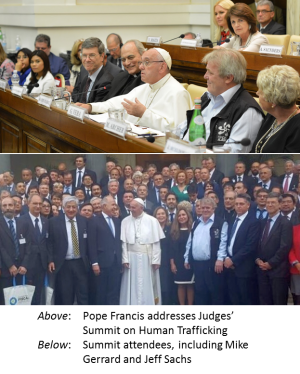By Ama Francis
After years of struggling to identify and address the needs of people compelled to move in the context of climate change, the international community is poised to affirmatively recognize the relevance of climate-induced migration and displacement.* Over the next week, world leaders are gathering in Marrakech, Morocco to adopt the Global Compact for Safe, Orderly and Regular Migration (“Global Compact” or “Global Compact for Migration”), an international agreement that garnered support from almost all United Nations Member States. The Global Compact recognizes climate change as a driver of migration, and promotes specific policy instruments for addressing climate-induced migration and displacement. Acknowledging that sudden- and slow-onset disasters can compel migrants to leave their countries of origin, the Global Compact also leaves open the possibility that states owe responsibility to migrants who are forcibly displaced by climate change’s adverse effects.

Next week, the Executive Committee of the Warsaw International Mechanism for Loss and Damage associated with Climate Change Impacts (ExCom) will also present its report on the issue at Conference of the Parties Twenty-Four (COP24) in Katowice, Poland. The ExCom report integrates recommendations from the Task Force on Displacement (“Task Force”), which was created under the Paris Agreement, and advocates for countries to include climate-induced migration and displacement in their National Adaptation Plans (NAPs). Together, the Global Compact and COP24 present an opportunity to establish international guidelines and leverage the Paris Agreement’s bottom-up approach to address climate-induced migration and displacement at the global and national level. They should offer a clarion call to states to immediately address and plan for climate migrants’ needs.
The Global Compact for Migration Recognizes Climate Change as a Driver of Migration and Proposes Specific Policy Tools for Addressing Climate-Induced Migration and Displacement
The Global Compact is the first non-binding international agreement to set a cooperative framework for improved migration governance. Negotiated in parallel with the Global Compact for Refugees, the Global Compact advances the ball on protection for migrants who fall outside the scope of the 1951 Convention Relating to the Status of Refugees. Together, the Global Compact for Migration and the Global Compact for Refugees address the full range of human mobility—from forced to voluntary movement. The Global Compact for Migration sets 23 objectives with corresponding commitments, policy instruments and actions to increase opportunities for regular migration. Such regular migration could fill labor market gaps, increase economic opportunities for migrants, and avert human rights violations.
The Global Compact is significant for climate-induced migration and displacement because it 1) recognizes climate change as a driver of migration; and 2) provides specific policy tools for addressing climate-induced migration and displacement resulting from both sudden- and slow-onset events.
The Global Compact for Migration aims to reduce the adverse drivers and structural factors that push people to leave their home countries, and names climate change as one of those drivers in Objective 2. The Global Compact for Refugees, in contrast, frames climate change as a force that interacts with drivers of migration without being a root cause itself. The Global Compact for Migration also goes well beyond the Global Compact for Refugees in raising the profile of climate migrants, including in Objective 2 a separate section on “natural disasters, the adverse effects of climate change, and environmental degradation.” This section details a number of actions that would lead to better governance of climate-induced migration and displacement, including improved data analysis and adaptation measures in countries of origin.
The Global Compact’s recognition of climate-induced migration and displacement may allow states to proactively address climate migrant needs. The Global Compact recommends specific policy tools for increasing regular migration opportunities for migrants on the move because of both slow-onset and sudden-onset disasters. Objective 5 recommends humanitarian visas, private sponsorships, and temporary work permits as tools to address migration due to sudden-onset natural disasters. Objective 5 also recommends planned relocation and visa options as tools where return to the country of origin is not possible, as could be the case with many Small Island Developing States. Finally, Objective 23 aims to increase international and regional cooperation in areas where irregular migration systematically occurs because of climate change and disasters.
Implementing the Global Compact will be a financial challenge that requires political will. The Intergovernmental Conference to Adopt the Global Compact in Marrakech will include two dialogues to strategize on how states will implement the agreement. Although the Global Compact is non-binding, its near universal support among UN Member States and its expressed commitment to improving regular migration pathways rather than restricting mobility across borders represent a shift in the migration governance regime. Rather than treating human mobility as a crisis, the global community could catalyze migration’s potential to improve livelihoods, and increase financial, skills and cross-cultural exchange.
ExCom Encourages States to Include Climate-Induced Migration and Displacement in Adaptation Planning, and Invites Coalition of Stakeholders to Support Efforts to Manage Climate-Induced Migration and Displacement
The Paris Agreement catalyzed international attention to climate-induced migration and displacement. Setting up the Task Force to develop recommendations to avert, minimize and address climate-induced migration and displacement, the Paris Agreement not only initiated an important body of work on climate-induced migration and displacement, it encouraged other international processes to take climate migrants into account. The Task Force’s recommendations were integrated into the ExCom’s report to be presented at COP24. The ExCom’s report could be significant for climate-induced migration and displacement because it 1) proposes that countries integrate climate-induced migration and displacement into adaptation planning; and 2) encourages a coalition of stakeholders to provide technical, financial, and research support to address climate-induced migration and displacement.
The ExCom report recommends that UNFCCC Parties pre-empt human suffering through adaptation planning. Paragraph 51(q) recommends that developing country Parties include climate-induced migration and displacement in their NAPs and receive assistance to do so. This would allow countries to approach climate-induced migration and displacement as an adaptation strategy. Accounting for climate-induced migration and displacement in NAPs would also encourage national governments to make use of national planning processes to reduce risk and vulnerability for climate migrants, the majority of whom will be displaced within their countries of origin.
The ExCom report also reiterates that concern for climate-induced migration and displacement should extend beyond the UNFCCC. Paragraph 51(t) encourages United Nations agencies and other relevant stakeholders to continue providing financial, technical and capacity-building support towards efforts to address climate-induced migration and displacement. The ExCom report further recommends that it work jointly with the Global Compact. Thus the ExCom report frames climate-induced migration and displacement as a policy issue that requires coordination between non-state and state actors, and the UNFCCC and other international processes.
The likely outcome of the ExCom’s report remains unclear. States could adopt the ExCom’s recommendations wholesale in a COP decision. States could also simply reference the ExCom report in a paragraph that notes and/or welcomes the ExCom report’s existence. If discussions on the implementing guidelines for the Paris Agreement overwhelm COP24, states may decide to punt their consideration of the ExCom’s report to a subsequent meeting. Either way, the ExCom has already agreed to continue the work of the Task Force for the next five years.
The Global Compact and the ExCom report build on a growing body of international processes that affirm that climate migrants deserve protection. The Sendai Framework for Disaster Risk Reduction 2015-2030, for example, adopted at the Third United Nations World Conference on Disaster Risk Reduction in Japan, recognizes climate change as a driver of migration in aiming to reduce disaster risk. The Nansen Initiative’s Agenda for the Protection of Cross-Border Displaced Persons in the Context of Disasters and Climate Change also articulates the challenge of addressing climate-induced migration and displacement, framing cross-border climate-induced migration and displacement as a humanitarian and development challenge, with implications for security as well.
**
When U.S. Customs and Border Protection officers threw tear gas into Mexico and U.S. authorities shut down the San Ysidro border to stop the migrant caravan from crossing into the U.S. last week, the drama of climate-induced migration and displacement came alive. Climate change is one of the lesser-reported factors that drove thousands of Central Americans to leave home (see this article). Facing declining crop yields and farming-based income in a changing climate, members of the migrant caravan joined the journey to seek asylum in the U.S. in part because of food insecurity. They also fled violence and poverty.
Human mobility in the context of climate change is multi-causal; it also exists along a spectrum of choice. Climate migrants experience varying amounts of agency in deciding when to leave, where to go, and how long to stay. Recognizing this spectrum, the Global Compact refers to migrants “compelled to leave their countries of origin” due to sudden- or slow-onset natural disasters (emphasis added). Thus the Global Compact leaves room for climate migrants to be treated as forcibly displaced. This language matters because forcible displacement implicates responsibility in a way voluntary migration does not. Framing climate-induced migration and displacement as purely voluntary would obscure the responsibility major emitting states arguably owe to climate migrants.
The Global Compact is commendable for encouraging states to increase opportunities for people to migrate regularly before migration becomes an act of desperation. The ExCom report is also commendable for encouraging states to integrate climate-induced migration and displacement in their adaptation planning. Between the Global Compact and the UNFCCC, the international community could step toward enhancing regular migration pathways and increasing national plans that account for climate migrants. Such integrated international and national action could circumvent a climate-induced migration and displacement crisis; and instead, secure human mobility as a win-win scenario.
*Multiple types of mobility exist in the context of climate change: migration, displacement and planned relocation. Migration entails movement that is predominantly voluntary, displacement describes situations where people are forced to leave their homes, and planned relocation refers to organized resettlement often supervised by the state with the consent or by request of the relocated community. This blog uses climate-induced migration and displacement as a shorthand to encapsulate the full range of mobility in the context of climate change—migration, displacement and planned relocation that is either temporary or permanent.



